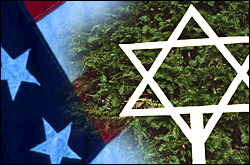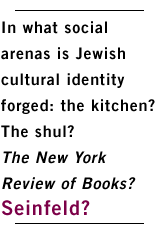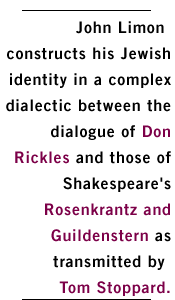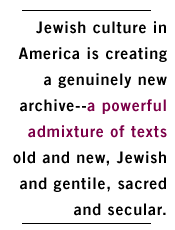Jewish in America
From: University of Michigan | By: Jonathan Freedman, Sara Blair EDITOR'S INTRODUCTION | A two-volume special issue of the journal Michigan Quarterly Review, edited by Sara Blair and Jonathan Freedman of the University of Michigan, brings together academic essays, high-level journalism, personal narratives, fiction, poetry and visual art responding to the transformations of Jewish experience in the United States during the last fifty years, and speculatively, extending into the twenty-first century.
EDITOR'S INTRODUCTION | A two-volume special issue of the journal Michigan Quarterly Review, edited by Sara Blair and Jonathan Freedman of the University of Michigan, brings together academic essays, high-level journalism, personal narratives, fiction, poetry and visual art responding to the transformations of Jewish experience in the United States during the last fifty years, and speculatively, extending into the twenty-first century. In the following introductory essay to the first of these two "Jewish in America" issues, Blair and Freedman respond to the multiplicity of representations, cultural forms, fashionings and refashionings that have defined the experience of Jews in America and continue to compel debate. The journal issues include works by Jews and non-Jews that engage contemporary controversies in the fields of politics, sociocultural dynamics, the arts and the relation of Jewish life in America to other historical periods, other geographical places.
[To obtain a copy of this special issue of MQR, or to subscribe to the journal, contact the Michigan Quarterly Review office at their website (www.umich.edu/~mqr/subscrip.htm)]
If any question is more unanswerable than J. Hector St. John de Crèvecoeur's famous inquiry, "what is an American?" it may well be: "what is a Jewish-American?" Jews have been insistently part of the American scene for more than a century (and longer), but have in that time been described as subversive aliens and true-blue patriots; outsiders to the cultural dominant and insiders to the national narrative; quizzical critics of capitalism and masters of the economic universe; makers of high culture, wizards of mass culture, purveyors of the middlebrow.
Indeed, virtually every attempt at defining Jews and/or Jewishness has raised as many questions as it has provided answers. Jews, of course, are a group organized by their relation to Judaism. But in what form: Conservative? Reform? Orthodox? Modern Orthodox? Reconstructionist? Ethical Culture? Add to the equation the notoriously lax attendance of even religiously identified Jews (as they are so ritually reminded on the High Holidays) and the fine old tradition of Jewish free-thinking, and that way of answering the question looks — well, complicated. Judaism is an inevitable and ineradicable component of Jewish-American experience; but the form it takes, the expression it finds, and the meaning that is made of it, are profoundly, even distinctively, various.
So too with many of the terms US culture uses for categorizing populations, most notably the language of "race." Luckily, American Jews were never fully submitted to the process of racialization in the Nazi sense of the word (although the anti-Semitic productions of Henry Ford and the ravings of Father Coughlin should not be swept under the rug). But Jews were, beginning in the fin-de-siècle, catalogued according to the intricate American typologies of racial identity in ways that testify to the unsettled if not ludicrous quality of the idiom of "race" itself. Over the past hundred and fifty years, Jews have been variously classified as Black, "Oriental," "Levantine," or some debased mixture of all of the above; more recently and insistently, they have been defined as "white," a source of both privilege and embarrassment.
Perhaps, then, it's better to think of Jews in terms of the fuzzy idiom of ethnicity — a discourse, with its Whiggish narrative of assimilation and attendant tropes like "the melting pot," that was largely formed with reference to Jews. But here, too, problems proliferate. Recently, the Jewish-as-model-ethnic narrative has come under severe attack by Jewish as well as non-Jewish critics, some pointing to its occlusions and uses as an enabling logic (both vis-à-vis the Jewish community and as an implicit mode of comparison with other ethnic communities); others rebelling against it by proudly proclaiming their Jewish difference; still others quietly (or not so quietly) enacting it in their upward mobility and concomitant drift to the neoconservative — or just plain conservative — Right. Analogously, cultural formations are often taken to be the defining characteristic of Jews, or, more precisely, Jewishness: but what culture, which formation? Jews have been called the People of the Book — not only the sacred ones parsed and interpreted in shul or study groups, but those interpreted and produced by the abundance of Jews who flooded into academe in the postwar period or those that compose the Great Tradition of Jewish-American writing (Malamud, Bellow, Roth, Paley, et al.). Yet Jews might also be — and have been — thought of as people of the Delicatessen, people of the Silver Screen and even, as late as the 1950s, people of the Gun.
 Who, in such a welter of representations, defines the "real" — the representative, the archetypal — Jew: the labor organizer or the Wall Street broker? A Jewish Mother or a woman Rabbi? Woody Allen or Mickey Cohen? The professor or the Princess? Rebbe Schneerson or the Klezmatics? In what social arenas is Jewish cultural identity forged: the kitchen? The shul? The New York Review of Books? Seinfeld? In what sites should the Jewish-American experience be located — the Lower East Side? The Upper West Side? Boca Raton? How might Jewishness look different if its sites of reference are extended even further — and not merely to Europe (Old World of oppression or nostalgia or escape) and Israel (site of identification, skepticism, ambivalence), but, as Ruth Behar's contribution eloquently testifies, to Cuba; or as Louis Simpson's autobiographical narrative suggests, to Jamaica? As Robert Pinsky reminds us, such material sites become "means, conduits" not only of spiritual experience but into history. What happens if the timeline of Jewish history in the United States is similarly distended? Does that history look, as Stephen J. Whitfield asks, like the end of or an alternative to exile? Or is Jewishness itself to be read (and valued) as a crucial integument of diasporic identity, an entirely new expression of an age-old wandering, vagrant sensibility (itself not out of keeping with at least one tendency in American letters, that represented by the Bard of Vagabondage, Walt Whitman)?
Who, in such a welter of representations, defines the "real" — the representative, the archetypal — Jew: the labor organizer or the Wall Street broker? A Jewish Mother or a woman Rabbi? Woody Allen or Mickey Cohen? The professor or the Princess? Rebbe Schneerson or the Klezmatics? In what social arenas is Jewish cultural identity forged: the kitchen? The shul? The New York Review of Books? Seinfeld? In what sites should the Jewish-American experience be located — the Lower East Side? The Upper West Side? Boca Raton? How might Jewishness look different if its sites of reference are extended even further — and not merely to Europe (Old World of oppression or nostalgia or escape) and Israel (site of identification, skepticism, ambivalence), but, as Ruth Behar's contribution eloquently testifies, to Cuba; or as Louis Simpson's autobiographical narrative suggests, to Jamaica? As Robert Pinsky reminds us, such material sites become "means, conduits" not only of spiritual experience but into history. What happens if the timeline of Jewish history in the United States is similarly distended? Does that history look, as Stephen J. Whitfield asks, like the end of or an alternative to exile? Or is Jewishness itself to be read (and valued) as a crucial integument of diasporic identity, an entirely new expression of an age-old wandering, vagrant sensibility (itself not out of keeping with at least one tendency in American letters, that represented by the Bard of Vagabondage, Walt Whitman)?
These questions press more insistently in the wake of the events we have come simply to call "September 11." What can we make of the new conflation of the terms "Jew" and "American" circulating around the world via Al Jazeera and the Internet? ("We have no hatred toward anyone, not even the Americans or Jews," writes one contributor to an online chat hosted by American Al-Qaeda supporters. "We just love to send them to hell where they belong in the eternal flames of fire.") Conjointly, the second intifada has produced an anguished set of responses among American Jews, some reaffirming a primal connection to the survival of the state of Israel, others feeling impelled by their own ethical as well as political commitments to heightened sympathy with the cause of the Palestinian people; all appalled by the return of an anti-Semitic idiom that had seemed to be a historical relic. Setting aside, if they can be set aside, the geopolitical dynamics of these developments, they raise questions of the most acute moment: what kind of present and future is being dictated by and for Jews, Americans, Jewish-Americans, via world events that seem to be outside our frame of reference, beyond our control? How can we — can we? — productively intervene in them, in the current American political context, much less in that of an explosive and violent world? What kinds of hard revisions do these hard facts enforce, as we come to terms with what now look like complacent assumptions that had governed our sense of the world for at least the past decade, if not longer? What new conditions of imaginative and experiential possibility do they create — or close off?
In the two "Jewish in America" issues of Michigan Quarterly Review, we have tried to assemble a collage of responses to these varied conundrums drawn from fiction writers, poets, memoirists, artists, anthropologists, historians, photographers and observers of everyday life; from religiously identified Jews, thoroughly secular Jews, non-identified Jews and others who are deeply engaged with these questions, like Arab-American Gregory Orfalea. We have tried, as we have done so, to pay special attention to works that attest to the diversity of Jewishnesses (generational, ideological, imaginative) in an equally, and increasingly, diverse America. The national and international crises that marked the preparation of this issue — we began to gather responses in the aftermath of September 11 and revisited contributions for publication as the current intifada accelerated — only heightened this quest for a multiplicity of perspectives. With the ground shifting beneath our feet, we felt only more strenuously the need to challenge, supplement, and complicate the available recastings of what it means to be Jewish in America. Obviously, we have not been able to include work that would touch on every single facet of this multifaceted phenomenon. While two special issues comprise many pages, they are not infinite. And not all the scholars, critics, fiction writers and poets we invited to supplement the voluminous submissions we received were able to do so, although we are deeply grateful to the number who did — and then bore with the cumbersome editorial process with remarkable patience and good grace. Nevertheless, we have tried to draw contributions from as many different voices, offered in as many different media, as we could, with two clear goals: to give a representative sampling of the imaginative and scholarly work underway in and around the terrain of Jewishness, broadly construed, within and without the academy; and to give pleasure and provocation.
 As we look over this issue and prepare the next, a few observations assert themselves. The first is the open-ended quality of writing and art about Jews and Jewishness — the sense of definitional freedom, even free play, that so many of these texts exploit. Charles Bernstein's poem, "Sign Under Test," is an exemplary instance. Although not a "Jewish" poem per se, it takes Jewishness as its very condition of possibility. Bernstein provocatively juxtaposes Talmudic motifs with playful, mass cultural modalities of expression:
As we look over this issue and prepare the next, a few observations assert themselves. The first is the open-ended quality of writing and art about Jews and Jewishness — the sense of definitional freedom, even free play, that so many of these texts exploit. Charles Bernstein's poem, "Sign Under Test," is an exemplary instance. Although not a "Jewish" poem per se, it takes Jewishness as its very condition of possibility. Bernstein provocatively juxtaposes Talmudic motifs with playful, mass cultural modalities of expression:
A husband returns home to find a burning cigar in his ashtray. He soon discovers a man in the broom closet. "What are you doing there?" — "Everybody's got to be somewhere." [Henny Youngman]And his ambit includes not only religious tradition and stand-up comedy, but also the highest of European high culture:
Rabbi Eliza asks, "When is a Jew no longer a Jew?" — "When the book is closed."
"The world is everything that is the case." But the case is locked in the trunk of a stolen car.
What those three Jews — Henny Youngman, Rabbi Eliza and Ludwig Wittgenstein — all share, it would seem, is acceptance of what is the case, even if that leads to a sense of enclosure (in the broom closet, the book, the trunk of a car) and a sense that even these bounded spaces contain infinite possibilities. Bernstein, the assimilated American Jewish poet, not only has all of these various authorities and the traditions they represent at his fingertips, but possesses the instincts of a master-thief, stowing them away in the stolen vehicle of his art. His mingling of cultural registers is one that many of our contributors practice. John Limon constructs his Jewish identity — or perhaps it would be better to say, his critique of thinking, in ethno-racial terms that would include Jewishness — in a complex dialectic between the dialogue of Don Rickles and those of Shakespeare's Rosenkrantz and Guildenstern as transmitted by Tom Stoppard; Esther Schor juxtaposes idioms appropriate to Brooklyn and the Guggenheim Museum. So too, virtually all of our commentators celebrate and privilege the mode of verbal dexterity. An expansive sense of the play of language, making and unmaking the world, informs Jacqueline Osherow's poetic fractals, Sharona Muir's alertness to the registers of mistranslation, Sharon Pomerantz's recording of the vagaries of the hustle and the hard sell. But what Bernstein encapsulates above all is the sense of possibilities that these discordant and delightful Jewish voices ("two Jews / three opinions," as Alisa Solomon reminds us in another, more somber context) bring to the American cultural table — or is it what they take from that table? The last line of his poem — remarkably inviting not despite but rather because of the foreboding that every morning's newspaper only enhances — issues a powerful request: "Save the last chance for me."
 As the last word of that last line suggests, the everything's-up-for-grabs aspect of Jewish-American imaginative expression is tied to the individualist quality of US culture: thus the remarkable proliferation, in the submissions we received, of personal narratives. By way of highlighting the variety and intensity of the personal mode, we have not only featured a large proportion of work of general interest, we also open the issue with a section devoted to a kaleidoscope of brief responses to questions about Jews and Jewishness in America, responses freed of the strictures of the full-length memoir and the nonfictional essay. In keeping with our sense of the admixture of the personal and the interpretive, of experience and commentary on that experience, we have entitled this section "Drashes," reflecting both the religious origins of the tradition of interpreting in personal terms the texts and contexts that shape experience and the quintessentially American practice of adopting tradition to modern circumstances.
As the last word of that last line suggests, the everything's-up-for-grabs aspect of Jewish-American imaginative expression is tied to the individualist quality of US culture: thus the remarkable proliferation, in the submissions we received, of personal narratives. By way of highlighting the variety and intensity of the personal mode, we have not only featured a large proportion of work of general interest, we also open the issue with a section devoted to a kaleidoscope of brief responses to questions about Jews and Jewishness in America, responses freed of the strictures of the full-length memoir and the nonfictional essay. In keeping with our sense of the admixture of the personal and the interpretive, of experience and commentary on that experience, we have entitled this section "Drashes," reflecting both the religious origins of the tradition of interpreting in personal terms the texts and contexts that shape experience and the quintessentially American practice of adopting tradition to modern circumstances.
Still, as Bernstein's parting shot suggests, the very emphasis on the personal has a complicated relation to a tradition which has always striven to affirm collective predications of identity and the power of history. Within the most powerful accounts of particular experience and the most accomplished moves to the autobiographical we read, we also noted, something larger is always at stake. Alisa Solomon's anguished recounting of her experiences with the Living Theater in Lebanon moves directly into a powerful Jeremiad against the American Jewish establishment's circle-the-wagons response to the current intifada. Similarly, Robert A. Rosenstone's memoir moves outward from family toward the raddled, internally riven culture of the 1930s radical Left. Pearl Abraham's rebellion against her traditional Hasidic upbringing leads her toward an Emersonian individualism that in turn leads her, paradoxically, to a different understanding of her Hasidic roots. Leonard Barkan's look back at his own experience as a self-negating Jew turns on a reading of Shakespeare's Merchant of Venice in contemporary Venice, then turns toward a remarkable conclusion that offers a provocative recasting of both Jewish and queer identities: "In comparison" with his negotiating multiple emblems of Jewish experience he encounters on the ground or in memory, Barkan writes, "being gay seemed almost simple." The qualifier in that sentence testifies that he knows full well the staggering complexity of both the categories he is working with, and of their intersection. Our point is that this move from the personal through the Jewish to rethinking categories of identity is so common in our contributors that we might even be tempted to think of it as a defining quality of American-Jewish imagination — if the very burden of that move weren't to call into question hard-and-fast definitions and resolutions of anything.
A final note: we are struck, in looking over both the voluminous submissions and the ones that we accepted, by the recurrence of certain defining texts and experiences as reference points: the Torah and Talmud, of course (as evidenced implicitly throughout, and explicitly in poetry like Osherow's or Daniel Mark Epstein's); Yiddish and Ladino languages and the remarkable trove of imaginative productions they produced, as well as the aforementioned canon of Jewish-American fiction and poetry written in English; and, inevitably, the Holocaust, which finds moving response in a number of contributions, including two from the second issue: Rick Hilles's plangent meditation and Misha Angrist's wry fictional rendering of second- and third-generation survivor culture. But equally recurrent as touchstones were Shakespeare's Merchant of Venice and T. S. Eliot's anti-Semitic lyrics, with which several of our contributors found themselves in spirited dialogue; the performance art of stand-up comedians; the imagery of Hollywood films; the musical stylings of Robert Zimmerman, a.k.a. Bob Dylan. All of which suggests to us that Jewish culture in America is creating a genuinely new archive — a powerful admixture of texts old and new, Jewish and gentile, sacred and secular, on which our writers and critics offer creative commentary and to which they make compelling response. Shaped in the American crucible of race and ethnicity, pushed and pulled by the American traditions of ahistorical and individualist thinking, empowered by a powerful sacramental and hermeneutic tradition yet challenged by that tradition's stunning variety of inflections, impelled to furious response by world crisis, these writers testify not only to the anguishing and joyous complexity of being Jewish in America, but to the creative energies such multiplicity demands.